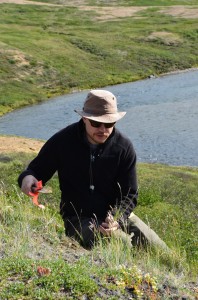How much food do you need to feed four botanists for four weeks?

Jeff Saarela collects grasses along the Soper River, Nunavut in 2012. Photo: Canadian Museum of Nature
Earlier this month I had the pleasure of a small behind-the-scenes tour of the collections facility of the Canadian Museum of Nature, officially known as The Natural Heritage Campus, in Gatineau, Quebec. The invitation arose from an earlier post about that institution’s new searchable database, a valuable tool for anyone with an interest in the natural science of northern North America.
This tour had two purposes: a chance for my visiting mother to see plant specimens collected about 100 years ago by her botanist father, Harold St. John, back when he was a grad student. And it was an opportunity to gather tape and photos ahead of that facility’s next open house in the fall. (Expect to hear more about that in early October.)
Anyway, this post is prompted by a press release about a summer expedition, sponsored by the Canadian Museum of Nature, as well as the Polar Continental Shelf Project of Natural Resources Canada. From the release:
An underexplored area of mainland Nunavut is the target of a fieldwork expedition this July by botanists from the Canadian Museum of Nature. The four-member team will survey and collect hundreds of plants along a 40-km stretch of the Coppermine River in western Nunavut from June 28 to July 29.
The results of the expedition will contribute to an ambitious museum-led project to produce a current flora, or scientific reference, for an estimated 800 species of vascular plants in the Canadian Arctic and northern Alaska.
During the four weeks, the team will travel, via helicopter, to three main camp sites where they will fan out to survey the diversity of plant life and collect specimens. They will cover an area that transitions from the treeline, where forest gives way to tundra-like vegetation, to the mouth of the river and the coastal community of Kugluktuk.
“The treeline zone is where you can find species from the boreal forest co-existing with some plants from the southern Arctic,” explains Dr. Jeff Saarela, a museum botanist co-leading the project with Dr. Lynn Gillespie. “We selected this area partly because we want to get a baseline record of what’s there now, since species may change distribution with a warming climate. These changes are likely to be first noticed near the treeline.”
The Museum has an interesting blog in which various staffers comment on activities. An earlier post from Roger Bull details the back-planning needed to prep the food that will sustain four (possibly six) hungry field researchers for 28 days on that Coppermine trip. (See how to turn big vats of stew into dehydrated packages at Good Food Leads to Happy Scientists.)
There’s real value in getting baseline information for areas that are experiencing change, or after they experience change. Be that from climate change, or something completely different.
Case in point: In 1925, while on the faculty of the then-named State College of Washington in Pullman, St. John lead a small group of students to the 10,000 foot level of Mt. St. Helens near Spirit Lake. As older readers will remember quite well, half the mountain blew out in spectacular fashion in 1980. (See a good retrospective of that momentous event in video, still photos and even song, in this montage by ABC/FOX Montana.)

Mt. St. Helens’ Spirit Lake filled with debris from the eruption. October 4, 1980. USGS Photograph taken by Lyn Topinka
Well, it took him a number of decades but St. John did write up a Flora of Mt. St. Helens, Washington for a magazine The Mountaineer, in 1976. Some of that earlier work provided a better understanding of what had grown there – to which post-eruption regeneration could be compared.
Here’s a vivid description of sudden, massive change from a June 2014 interview by Kelly Clarke for the Monthly Portland: Life Goes On: Mount St. Helens’ Flora and Fauna:
After 34 years on the volcano, ecologist Charlie Crisafulli reflects on rebirth at Mount St. Helens.
What’s your first memory of the mountain?
It was two months after the eruption. I flew in by helicopter. The forest was flattened, the streams choked with volcanic ash and pumice—seemingly lifeless as far as the eye could see. I saw the steaming, gaping crater and realized something incredibly profound had happened here. It was beyond all senses to comprehend the scale and the extent of change. It was exciting…and also chilling. I was only 22, but I knew right away this was a mecca. We have been going back to the same plots for 33 years now—watching how species come, go, and their populations change, often in very dramatic ways.
The good news – for the Mount St. Helens eruption at least – is that nature is amazingly adept at rejuvenation. Here’s how the interviewee, Charlie Crisafulli, put it:
It has to do with hope. All of us go through tragedy at some point. What is more hopeful than looking at a shattered landscape and seeing a sprig of green come up through the cold, dark ashes? Life marches on. That’s the poetry of the place.
Increasingly-apparent shifts caused by climate change lend added urgency to studies like the Coppermine River field work. But for whatever reason, there’s merit in documenting more completely what grows in North America’s far north. All the better to understand and protect what’s there.

Jennifer Doubt, the curator of National Herbarium of Canada showing Martha St. John Martin specimens collected by Harold St. John nearly a century ago. Photo: Lucy Martin
Tags: botany, canada, Canadian Museum of Nature, ecology, Harold St. John, Mt. St. Helens, Natural Heritage Campus, Quebec, science








One granola bar and one apple?
Here’s more about the expedition route and goals.
Anyone interested can follow along via Twitter as well.